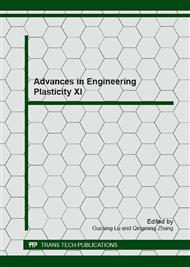[1]
W.Goldsmith, S.A. Finnegan, Penetration and perforation process in metallic targets at and above ballistic velocities, Int J Mech Sci.13(1971) 843–66.
Google Scholar
[2]
G.R. Johnson, W.H. Cook, A constitutive model and data for metals subjected to large strains, high strain rates and high temperatures, In: Proceedings of the seventh international symposium on Ballistics. The Hague; 1983.
Google Scholar
[3]
G.R. Johnson, W.H. Cook, Fracture characteristics of three metals subjected to various strains, strain rates, temperatures and pressures,Eng Fract Mech. 21(1985)31–48.
DOI: 10.1016/0013-7944(85)90052-9
Google Scholar
[4]
T. Borvik, O.S. Hopperstad, T.Berstad, M.Langseth, Numerical simulation of plugging failure in ballistic penetration, Int J Solids Struct.38 (2001) 6241–64.
DOI: 10.1016/s0020-7683(00)00343-7
Google Scholar
[5]
T Borvik, M Langseth, O.S. Hopperstad, K.A. Malo, Perforation of 12 mm thick steel plates by 20 mm diameter projectiles with flat, hemispherical and conical noses part I: experimental study, Int J Impact Eng. 27 ( 2002)19-35.
DOI: 10.1016/s0734-743x(01)00034-3
Google Scholar
[6]
T Borvik, O.S. Hopperstad, T. Berstad, M. Langseth, Perforation of 12 mm thick steel plates by 20 mm diameter projectiles with flat, hemispherical and conical noses part II: numerical simulations, Int J Impact Eng .27 (2002)37-64.
DOI: 10.1016/s0734-743x(01)00035-5
Google Scholar
[7]
T.Borvik, A.H. Clausen, O.S. Hopperstad, M. Langseth, Perforation of AA5083-H116 aluminum plates with conical nosed steel projectiles – experimental study, Int J Impact Eng. 30(2004) 367–84.
DOI: 10.1016/s0734-743x(03)00072-1
Google Scholar
[8]
Version 6.7 ABAQUS analysis user's manual. 2 (2007).
Google Scholar
[9]
S. Dey, T. Borvik, X. Teng, T. Wierzbicki, O.S. Hopperstad, On the ballistic resistance of double-layered steel plates: an experimental and numerical investigation, Int J Solids Struct. 44(2008) 6701-23.
DOI: 10.1016/j.ijsolstr.2007.03.005
Google Scholar
[10]
D.W. Zhou, W.J. Stronge, Ballistic limit for oblique impact of thin sandwich panels and spaced plates, Int J Impact Eng. 35 (2008) 1339-54.
DOI: 10.1016/j.ijimpeng.2007.08.004
Google Scholar
[11]
M.A. Iqbal, A.Chakrabarti, S. Beniwal, N.K. Gupta, 3D numerical simulations of sharp nosed projectile impact on ductile targets, Int J Impact Eng. 37 (2010) 185-195.
DOI: 10.1016/j.ijimpeng.2009.09.008
Google Scholar
[12]
M.A. Iqbal, P.K. Gupta, V.S. Deore, S.K. Tak , G. Tiwari , N.K. Gupta, Effect of target span and configuration on the ballistic limit, Int J Impact Eng. 42 (2012) 11-24.
DOI: 10.1016/j.ijimpeng.2011.10.004
Google Scholar


